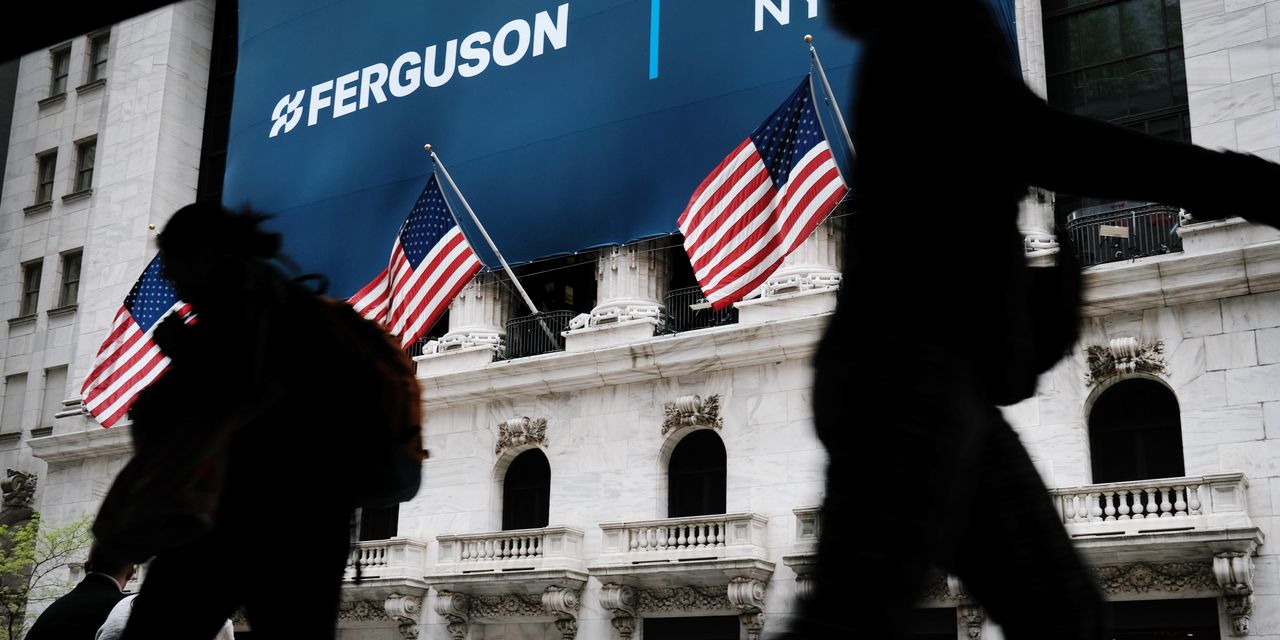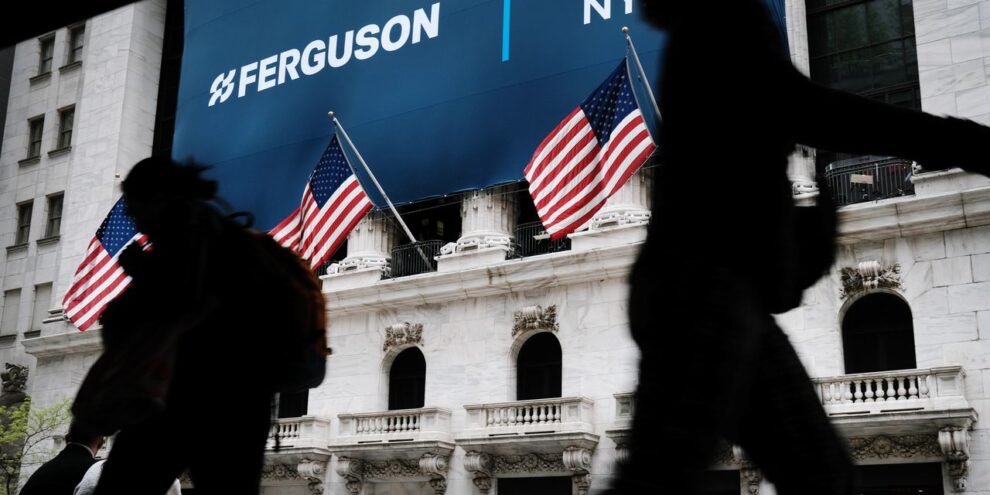
U.S. stocks were trimming losses late Friday afternoon, with the S&P 500 index trading around bear-market territory and the Dow Jones Industrial Average on track for its longest string of weekly losses in 90 years.
How are stocks trading?
- The Dow Jones Industrial Average DJIA, -0.28% fell 158 points, or 0.5%, to about 31,118.
- The S&P 500 SPX, -0.35% dropped about 20 points, or 0.5%, to 3,880, after earlier trading in bear market territory.
- The Nasdaq Composite COMP, -0.79% was down 106 points, or 1%, at 11,279.
On Thursday, the Dow industrials and S&P 500 booked their lowest closes since March 2021, according to Dow Jones Market Data. For the week, the Dow is heading for a 3.8% drop, while the S&P 500 is on pace to fall 4.1% and the Nasdaq is poised to tumble 5%, FactSet data show, at last check.
What’s driving markets?
Friday morning’s bounce was short-lived.
The rally provided an opportunity for traders to “lighten up on exposure” ahead of the weekend, selling amid “growing uncertainty and anxiety” about the direction of the economy as the Federal Reserve raises interest rates to fight high inflation, according to Wayne Wicker, chief investment officer at MissionSquare Retirement.
“Investor psychology is driving a lot of this,” Wicker said in a phone interview Friday, referring to the selloff.
The S&P 500 traded into bear-market territory Friday afternoon. A close below 3,837.25 would confirm that the S&P 500 entered a bear market, marking a fall of 20% or more from its Jan. 3 record close.
Read: The S&P 500 is trading in bear-market territory. How far could it fall?
“Stocks remain on a shaky footing. Investors’ list of worries grows ever larger,” said Fawad Razaqzada, market analyst with City Index and Forex.com, in a note.
“Inflation. Interest-rate hikes. Low economic growth. Stagflation. Recession. Perhaps most importantly for stocks, the Fed is not there to provide cushion, like before,” he wrote.
Stocks were initially buoyed after the People’s Bank of China on Friday cut in its rate on five-year loans, aimed at shoring up weak housing sales by reducing mortgage costs. The country has been battling COVID outbreaks, with lockdowns in industrial hubs such as Shanghai blamed for weak factory and consumer activity data in April.
But analysts said the move also underlined concerns.
“Where the rest of the world is thinking of raising rates because of inflation, they’re cutting rates in order to help the economy,” said JJ Kinahan, chief market strategist for online brokerage firm tastytrade Inc., in a phone interview. “I think that’s a little bit of a warning sign,” as U.S. companies that benefit from demand in China may be hurt by a slowing Chinese economy as well as supply-chain disruptions linked to the country’s lockdowns, he said.
Nearly all of the S&P 500’s 11 sectors were trading down Friday afternoon, with only real estate showing a slight gain, according to FactSet, at last check.
Friday is the final day of trading before the expiration of options tied to stocks and exchange-traded funds, which is seen potentially contributing to volatility ahead of the end of the session.
Major U.S. stock indexes remain on track for another week of losses, with investors worried about whether soaring inflation can be brought under control by the Federal Reserve without derailing the economy.
The Dow is heading for its eighth straight weekly decline, which would be its longest since April 1932, according to Dow Jones Market Data. The S&P 500 and Nasdaq Composite were on track for a seventh straight weekly fall, the longest streak for each since 2001.
Major retailers this week, such as Walmart WMTand Target TGT reported disappointing profits, against a backdrop of rising expenses and inflation.
Mark Hulbert: Here’s the real reason the stock market is coming unglued — and it isn’t because of weak earnings
This past week has shown that the risk of economic downturn, fears that high inflation is cutting into corporate performance and rising borrowing costs remain the major worry for markets, particularly after Fed Chairman Jerome Powell said the central bank “won’t hesitate” to lift rates beyond neutral to curb high inflation, according to Christian Stocker, lead equity sector strategist at UniCredit Bank in Munich.
“In this environment, investor sentiment is fickle and markets are likely to remain choppy to both sides until there is greater clarity in terms of recession, rates, and geopolitical risks,” Stocker said.
The U.S. economic data calendar is empty for Friday, but next week will bring another round of inflation data, personal consumption expenditure prices excluding food and energy.
Which companies are in focus?
- Shares of Ross Stores Inc. ROST, -22.59% slumped around 24% after the retailer became the latest to report disappointing quarterly results and trim its outlook, blaming higher inflation and rising freight and wage costs.
- Deere & Co. DE, -13.65% shares dropped about 15% after the agriculture, construction and forestry equipment maker reported better-than-expected fiscal second-quarter profit and revenue.
- Applied Materials Inc. AMAT, -4.70% stock was down 7.9% after the chip-equipment maker reported a miss on profit, revenue and forecast amid continued supply chain woes.
- Foot Locker FL, +4.79%, the athletic footwear and apparel retailer, saw its shares rise almost 4% after it reported first-quarter profit that beat expectations.
How are other assets trading?
- The yield on the 10-year Treasury note TMUBMUSD10Y, 2.785% fell about 7 basis points to around 2.78%. Yields and debt prices move opposite each other.
- The ICE U.S. Dollar Index DXY, +0.35%, a measure of the currency against a basket of six major rivals, rose 0.4%.
- Bitcoin BTCUSD, -3.22% was off 3.9% at $29,032.
- Oil futures rose, with the U.S. benchmark CL.1, +0.44% edging up 0.5% to trade around $110 a barrel.
- In gold futures GC00, +0.07%, gold for June delivery edged up less than 0.1% Friday to settle at $1,842.10 an ounce. The yellow metal rose 1.7% for the week, breaking a string of four consecutive weekly declines, according to Dow Jones Market Data.
- In European equities, the Stoxx Europe 600 SXXP, +0.73% closed 0.7% higher Friday but slipped 0.5% for the week. London’s FTSE 100 UKX, +1.19% ended 1.2% higher Friday and booked a weekly decline of 0.4%.
- In Asia, the Shanghai Composite Index SHCOMP, +1.60% finished 1.6% higher Friday for a weekly gain of 2%. The Hang Seng Index HK:HSI jumped about 3% Friday, bringing its weekly gain to 4.1%. Japan’s Nikkei 225 JP:NIK rose 1.3% Friday for a weekly gain of 1.2%.
—-Barbara Kollmeyer contributed to this report.





